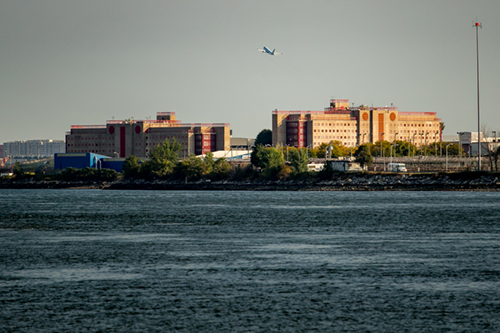Citylimits.org | March 19, 2019
Over the past two years there has been a steady drumbeat of op-eds about how terrible the city’s jails and prisons on Rikers Island are and how great is the need to reform the city’s criminal justice system. It has been a power elite cause as well: Even the head of the Ford Foundation got into the act with an op-ed in The Atlantic. Someone has also financed promotional movies to sell the cause and one-sided panel discussions are everywhere, like the most recent at the School of Visual Arts on March 12th.

Adi Talwar
George R. Vierno Center on Rikers Island, seen from the Bronx.
But there is a huge problem: There is no connection between the administration-of-justice reforms that are truly needed and actually closing Rikers. Even less clear is the connection between three completely different ideas: systemic justice reform, closing Rikers, and spending $11 billion to build four new tower-jails in downtown neighborhoods in all Boroughs except Staten Island.
New Yorkers would be right to wonder what is going on. TheDaily News, to its credit, called out the game behind the scenes with the headline: “Potential Closure of Rikers Island Sparks Dream Opportunity for Developers, Planners.” The upshot is that we are now embroiled in the spectacle of real-estate drama rather than talking about how to enact (and pay for) the administrative, managerial, and legal reforms that would actually reduce the number of people who need a bed on Rikers.
The background is simple: Big foundations with a criminal justice reform agenda agreed to pay for the work of an activist “Commission” to propose reforms, ostensibly at the request of former City Council Speaker Melissa Mark-Viverito, whose election campaigns have been heavily financed by the real estate industry. The Commission was filled with long-term criminal justice advocacy groups, various members of the city’s power elite, ‘Close Rikers’ advocates and sympathizers, and, oddly, a few people with real estate connections, such as the CEO of Forest City Ratner. Reformer and ex-judge Jonathan Lippman chaired the Commission that bears his name.
The Commission produced two reports, found here. In those reports, the Commission outlines an excellent case for diversion programs and for the reforms of sentencing, bail, and case processing. But then, in an incredible leap of logic, it tries to sell us on spending $11 billion to build four new tower-jails in residential neighborhoods, all near the downtown borough courthouses, and then spend an additional $15-22 billion to redevelop Rikers Island as a vaguely described “mixed use development.” (The specifics of that mixed-use plan would be something the real estate industry works out once they have their paws on Rikers Island, which the Commission notes is conveniently above the flood plain). That initial $11 billion figure also includes an eyebrow raising carve-out: $250 million to build a brand-new training college for the corrections officers—yet another real-estate project! The final price tag is not clear, as the additional costs of implementing the Commission’s useful laundry list of non-real-estate related administrative and managerial reforms of the administration of justice are not priced out or sequenced in a logical way.
Mayor de Blasio has bought into “let’s build new jails” part of the idea. The real-estate project is therefore advancing quickly, steamrolling over a lot of legitimate concerns, complete with Neighborhood Advisory Councils that present a City Hall-curated form of community input. All of this is being done without regard for the obviously less expensive alternative of simply renovating the buildings on Rikers. The advocates are getting pretty heated, too. Judge Lippman even claims (wildly as well as wrongly) that if you don’t like his idea, “then you support mass incarceration” which is as insulting as it is ridiculous.
In a January 2019 meeting with a Community Board 1 land-use committee, Mayoral staff dismissed the far simpler and cheaper idea of renovating the existing jails on Rikers, claiming that it would be “impossible” – a policy position that stretches credulity. Instead, the Mayor’s team prefers to talk about the glassy design ideas for new jails that a clever architect sold to the Commission, the same architect who already designed and supervised a new building on Rikers that went up under Bloomberg. (Judge Lippman’s praise of the marvelous things architects can do with jails can be found at the Cityland video cited in the footnotes). The Wall Street Journal‘s recent coverage of the luxury-condo version of jail designs is here. When backed into a corner, advocates complain of isolation and logistical difficulties in getting people to court.
But Rikers is not isolated from Queens, and is only 1550 feet from the Bronx where most of the incarcerated people come from. Why not bring the ferry back to Rikers or, smarter still, have the East River Ferry make Rikers a regular stop? After all, there used to be a ferry before the road was built and you don’t need a fleet. And while you are at it, why not build a low-cost (under $1 million) pedestrian footbridge to the Bronx where there is a bus stop? Other places have done that for cheaper. So why not at least investigate the renovation option rather than dismiss it?
Also troubling: The “Build New Jails” advocates have adopted a two-step Bait and Switch political strategy that is oddly familiar. Step 1: Demonize something with a slogan that confuses a lots of complex issues (in this case the concept of mass incarceration, the design of the existing buildings on Rikers and the location of Rikers) while setting out a new slogan as bait, a single public good that gets Exalted Above All Others, which in this case is “ending mass incarceration.” Step 2: use the ensuing confused debate over what the Demonized and the Exalted things really are to distract everyone from the switch: big real estate deals behind the scene. We’ve seen how the De Blasio team and REBNY used that playbook with the affordable housing issue. In that case they cast “zoning regulations, landmarks, historic districts, and ‘NIMBY’ community groups” as the Demon. The Exalted & Vaguely Defined Public Good used as bait was “affordable housing.” The switch was the subsequent give-away of FAR to the real estate industry for a building spree of luxury towers, a deal in which the politicians (universally beholden to big real estate according to the Real Deal here) agreed to adopt a see-no-evil policy stance about the negative effects of the switch.

